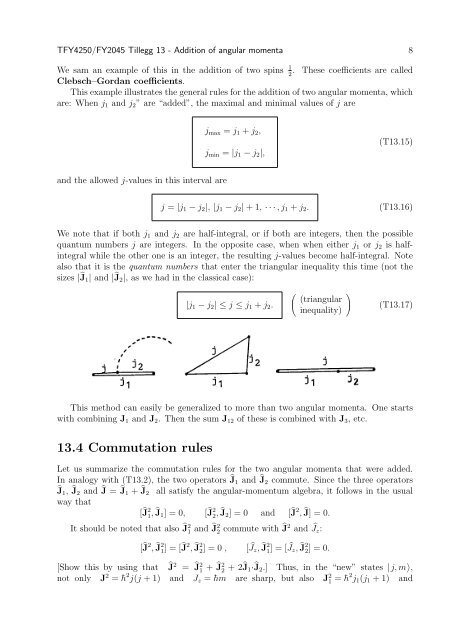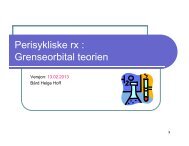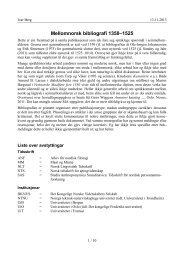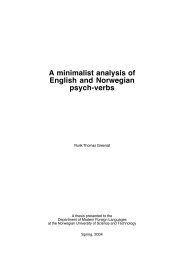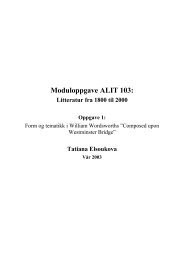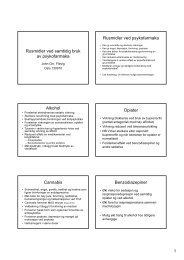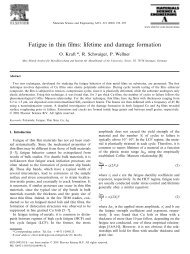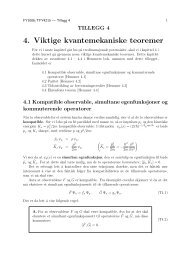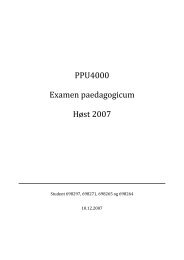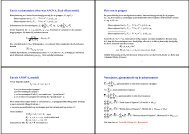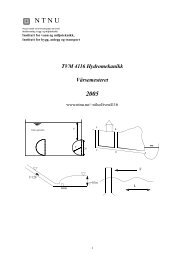Create successful ePaper yourself
Turn your PDF publications into a flip-book with our unique Google optimized e-Paper software.
TFY4250/FY2045 Tillegg <strong>13</strong> - <strong>Addition</strong> <strong>of</strong> <strong>angular</strong> <strong>momenta</strong> 8<br />
We sam an example <strong>of</strong> this in the addition <strong>of</strong> two spins 1.<br />
These coefficients are called<br />
2<br />
Clebsch–Gordan coefficients.<br />
This example illustrates the general rules for the addition <strong>of</strong> two <strong>angular</strong> <strong>momenta</strong>, which<br />
are: When j 1 and j 2 ” are “added”, the maximal and minimal values <strong>of</strong> j are<br />
j max = j 1 + j 2 ,<br />
j min = |j 1 − j 2 |,<br />
(T<strong>13</strong>.15)<br />
and the allowed j-values in this interval are<br />
j = |j 1 − j 2 |, |j 1 − j 2 | + 1, · · · , j 1 + j 2 .<br />
(T<strong>13</strong>.16)<br />
We note that if both j 1 and j 2 are half-integral, or if both are integers, then the possible<br />
quantum numbers j are integers. In the opposite case, when when either j 1 or j 2 is halfintegral<br />
while the other one is an integer, the resulting j-values become half-integral. Note<br />
also that it is the quantum numbers that enter the tri<strong>angular</strong> inequality this time (not the<br />
sizes |Ĵ1| and |Ĵ2|, as we had in the classical case):<br />
|j 1 − j 2 | ≤ j ≤ j 1 + j 2 .<br />
(<br />
(tri<strong>angular</strong><br />
inequality)<br />
)<br />
(T<strong>13</strong>.17)<br />
This method can easily be generalized to more than two <strong>angular</strong> <strong>momenta</strong>. One starts<br />
with combining J 1 and J 2 . Then the sum J 12 <strong>of</strong> these is combined with J 3 , etc.<br />
<strong>13</strong>.4 Commutation rules<br />
Let us summarize the commutation rules for the two <strong>angular</strong> <strong>momenta</strong> that were added.<br />
In analogy with (T<strong>13</strong>.2), the two operators Ĵ1 and Ĵ2 commute. Since the three operators<br />
Ĵ 1 , Ĵ2 and Ĵ = Ĵ1 + Ĵ2 all satisfy the <strong>angular</strong>-momentum algebra, it follows in the usual<br />
way that<br />
[Ĵ2 1, Ĵ1] = 0, [Ĵ2 2, Ĵ2] = 0 and [Ĵ2 , Ĵ] = 0.<br />
It should be noted that also Ĵ2 1 and Ĵ2 2 commute with Ĵ2 and Ĵz:<br />
[Ĵ2 , Ĵ2 1] = [Ĵ2 , Ĵ2 2] = 0 , [Ĵz, Ĵ2 1] = [Ĵz, Ĵ2 2] = 0.<br />
[Show this by using that Ĵ2 = Ĵ2 1 + Ĵ2 2 + 2Ĵ1·Ĵ2.] Thus, in the “new” states |j, m〉,<br />
not only J 2 = ¯h 2 j(j + 1) and J z = ¯hm are sharp, but also J 2 1 = ¯h 2 j 1 (j 1 + 1) and


